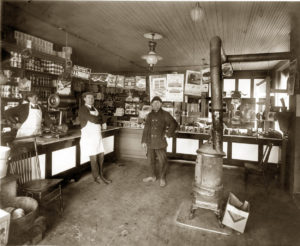
Personalising the digital journey
Why does personalisation matter?
Providing the right content in the right context remains king in the digital experience. Personalisation enables you to do this but the truth is that many brands are still playing catch-up – with site pages littered with products which the viewer has already bought or even worse, content which is completely irrelevant . Personalisation has to get smarter and feel like it fits more seamlessly into the digital journey.
"75% of consumers are more likely to buy from retailers that provide personalisation"
Source: Accenture: Personalisation Pulse Check Survey 2016).
So if you’re still writing that business case for more budget to be able to personalise your digital marketing, here it is.
The History of Personalisation
Let’s take a look at the history of personalisation, because it’s easy to think that this is something new, but it’s actually been around since the 18th century.
[bctt tweet="‘75% of of consumers are more likely to buy from retailers that provide #personalisation #marketing' http://bit.ly/2uVtEuT @Talk_Strategy @Accenture" quote="‘75% of of consumers are more likely to buy from retailers that provide #personalisation #marketing' http://bit.ly/2uVtEuT @Talk_Strategy @Accenture"]18th Century Personalisation
 In the 18th Century, good retailers would recognise their customer and tailor their pitch according to what they knew about them.
In the 18th Century, good retailers would recognise their customer and tailor their pitch according to what they knew about them.An example of this is a story from the history of Lock and Co Hatters of St James. As the story goes, once upon a time, in the 18th Century, a trusted customer could arrive outside the shop door on their carriage, shout ‘hat’ and then leave.
The shop’s workmen would then refer to their records for details of that customer’s hat size and style preferences before making the hat and delivering it directly to their home. This is personalisation back in the 18th Century and today this is effectively personalised shopping that we know, but instead without having to go to the shop and being able to request online instead.
The birth of Online shopping
This form of personalisation started the basis of all good retail for hundreds of years and it was only with the rise of supermarkets and chain stores that retail began to get impersonal. This was a result of chasing the masses and volume of customers, rather than seeking to fulfil individual preferences.Then the world wide web arrived. This drove the engine of commerce and online retail made little if any effort to personalise the offering, instead making the assumption that in order to deliver on a mass scale, customers were more or less the same. Fast forward a few years to the present day and personalisation is very much back on the agenda.
Falling margins driven by intense competition and rising customer acquisition costs mean that every conversion counts, and it’s a personalised experience that 75% of consumers are telling us makes them more likely to buy.
Then there was Amazon…With the rise of ecommerce along came Amazon. Amazon heavily used personalisation with its similar product recommendations, leading many retailers to emulate its model. Like so much in online retail, web personalisation was first introduced at scale by Amazon. Their ‘customers who bought this also bought that’, introduced a degree of personalised recommendation to the sales cycle based on your previous shopping habits.

35% of Amazon’s revenue is generated by its recommendation engine which goes to show how powerful those recommendations are in influencing buying decisions.
[bctt tweet="‘35% of Amazon's revenue comes from its recommendation engine #personalisation’ @Talk_Strategy http://cnb.cx/2a1Rlf1" quote="‘35% of Amazon's revenue comes from its recommendation engine #personalisation’ @Talk_Strategy http://cnb.cx/2a1Rlf1"]Evolution of personalisation
The next stage of personalisation and its evolution, which is one we are seeing more of now. With the use of data personalisation can now utilise huge quantities of information about individual user journeys. Bespoke content is then displayed based on an understanding of patterns of behaviour.For example, you may analyse the journeys on your website and identify people who visit a particular page are more likely to purchase than those that don’t visit that certain page.
It might therefore be worth testing if offering a bespoke content message or discount offer to users when they arrive at that page, with the aim of driving more conversions.
Alternatively, analysis might reveal that those arriving from specific search keywords will tend to be interested in a specific product area or attribute, enabling the retailer to serve a tailored home page to those users.
This personalisation meets the barrier of ‘real’ personalisation, as it delivers a bespoke experience based on an individual user’s behaviour.
Boots is a brand that utilises purchase behaviour of its customers to provide customisable promotion schemes that enable loyalty card holders to choose which products they receive discounts on. This is all tailored to purchase behaviour, providing relevant offers and promotions to their customers.
Advanced personalisation
This is then moves us on to advanced personalisation. First and foremost, customers need to both feel confident in that retail brands ability to keep their data safe and also be clear in the value that they will receive in sharing their detailed personal preference data.For the brand it makes it increasingly difficult to maintain a single look and feel for a brand’s website when every page is potentially bespoke to the individual user.
Even with these barriers aside, this type of personalisation is the Holy Grail for all online retailers. Hundreds of years of commerce have proven the effectiveness of personalised experiences and this is the closest that the web can get to delivering the sort of personalisation and convenience that St James’ hatters – the earlier example, from the 18th century that had the same affect all those years ago.
Advanced personalisation in action
An example of a brand that has taken this leap into implementing an advanced personalisation digital strategy is Very.co.uk. Back in 2015 it went completely personalised and saw its profits surge by 43% in the first year.
This means that a fashion shopper with Very.co.uk will find their favourite clothing brands ‘front of shop’, while the homemaker shoppers will see furniture and homeware products.So how did they do this?
The brands data scientists used the wealth of customer data to develop an in-house algorithm to predict consumer behaviour. The algorithm produces 200 million promotion affinity scores, which rank the relevance of offers for each customer.
Very.co.uk can create a staggering 1.2 million versions of its homepage, with flexible elements including the type of promotional messages and their position on the page. The retailer has also begun personalising search results so that when shoppers looking for a particular item they will see the brands and styles they like listed first - instead of this being a random search result.
 The clever use of a contextual, personalised web banner serves multiple purposes. It ensures the customer knows that they have been on the website before, adding trust and familiarity. It also allows you to showcase products that are relevant in real time, in the most valuable area of their website - the homepage.
The clever use of a contextual, personalised web banner serves multiple purposes. It ensures the customer knows that they have been on the website before, adding trust and familiarity. It also allows you to showcase products that are relevant in real time, in the most valuable area of their website - the homepage.Source: Retailweek.com Personalisation reality
Given all of this potential opportunity to enhance a customers experience with personalisation, we as marketers still have a long way to go to utilise it’s potential.
The quote I’m about to talk through is from 2014, but I still see it as relevant today as I myself experience this online which many will call personalisation and I’m sure many of you still do too.
"Personalisation wasn't supposed to be a cleverly veiled way to chase prospects around the web, showing them the same spammy ad for the same lame stuff as everyone else sees. No, it is a chance to differentiate at a human scale, to use behaviour as the most important clue about what people want and more important, what they need.”
Seth Godin (2014)
That experience of being ‘chased around the web with the same spammy ad that everyone else sees’ is even 3 years on from this quote is a regular experience online. With the advances in technology, the amount of data available and programmatic advertising techniques, this type of marketing is not only ineffective, it also isn’t necessary and wouldn’t be what I would class as personalisation.
Causes of unsubscribes
![]()
Source: DMA Consumer Email Tracker Report 2016
Also ironically the number one reason that consumers have told us as to why they unsubscribe from email marketing, is because the content wasn’t relevant.
Everyone gets hung up on frequency with email marketing, questioning if you’re sending too many emails but actually frequency isn’t the issue. It’s the irrelevant content that drives the unengagement and unsubscribe. Sending a high volume of emails that are relevant will retain engagement. It’s when you increase the volume and continue to send irrelevant, non-personalised and non-targeted content that you will see unsubscribes increase. It’s clear from the DMA Consumer Tracker report, that consumers want ‘relevant’ content.
This makes our jobs as marketers pretty simple and goes back to the 18th century example, where a customer tells us what they want and we provide that utilising the behaviour and data that they have provided to us before.
When does personalisation become creepy?Lets take a look at when personalisation over steps the mark and becomes creepy…
 As you can see from this tweet (Source: Brandwatch) that Kim has posted, her Dad is in assisted living. He then receives a Christmas basket from the local mortuary.
As you can see from this tweet (Source: Brandwatch) that Kim has posted, her Dad is in assisted living. He then receives a Christmas basket from the local mortuary.Now this is not only creepy, it is invasive and insensitive. It may be a case that you’re customers are providing you with a lot of data but responsible marketing needs to come into play to determine if you actually use it all.
'Target' - the US brand - is another example, where they targeted a customer with pregency products based on the data that they had available to them. The customers father found out and because she was underage, complained to Target. It then transpired that his daughter was actually pregnant but didn’t tell her Dad. In this case, Target knew about his daughters’ pregnancy before he did!
Moral of the story - We as marketers must use our customers data in a responsible manner.
There is a fine line between personalisation & being creepySo whilst personalisation can be incredibly powerful there is a real fine line between being personalised, relevant and useful to the recipient and it just being invasive & creepy.
An example I like to use is if you met someone for the first time and they know everything about you, you would feel pretty awkward. Use this same analogy for your customers.
Are you creating your next personalisation strategy or want to improve an existing one?For our top 5 steps on how to create an effective personalisation and retargeting strategy check out our recorded webinar with Pure360 or get in touch with us.

https://uk.linkedin.com/in/jennatiffany
About the author
Jenna Tiffany is Founder & Strategy Director at Let'sTalk Strategy providing consultancy services across the digital marketing mix. Jenna has over ten years' marketing experience within B2B and B2C and both client and agency side.
Communications Ambassador for CIM Greater London Region, an advisory board member the DMA North and a member of the DMA's Email Marketing Council. Jenna's expertise ranges in working with both small and large brands to analyse and develop their key journeys & wider digital marketing activities, developing best in class digital marketing strategies & campaigns to deliver ROI. As a proven thought-leader, competent public speaker and publisher, Jenna can be regularly seen sharing her latest trends and key industry topics.
